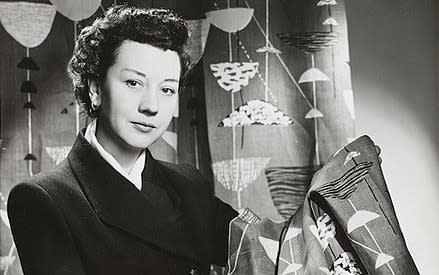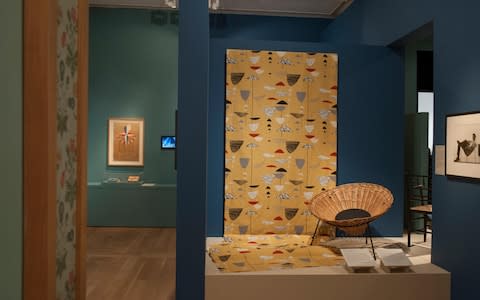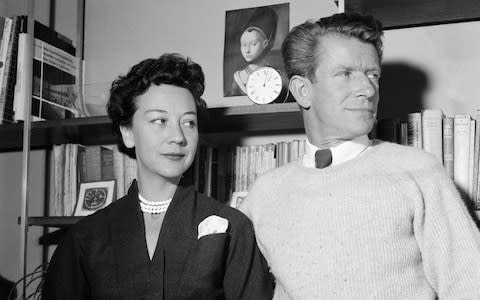Lucienne Day: the designer who helped post-war Britain chuck out the chintz

To celebrate 100 years since British women were given the right to vote, The Telegraph – alongside the Mayor of London’s #BehindEveryGreatCityCampaign – is running a weekly series.
‘Hidden Credits’ looks back and celebrate individual women who have smashed glass ceilings, helped change society for the better and given the UK’s capital something to boast about.
Though not a household name today, Lucienne Day’s abstract designs are said to have hung in every contemporary living room in the country during her reign as the foremost British textile designer of the mid-20th century.
Born Désirée Lucienne Conradi in 1917, Day was brought up in the south London suburbs by her English mother and Belgian father. Her focus on designing began at an early age and was met by her attendance at the Croydon School of Art and then, from 1937 to 1940, at the Royal College of Art.
There, in her final year, she met furniture designer Robin Day, who was already establishing his impact on British cultural history. Marrying in 1942 and thereafter having their only child, Paula, the pair would go on to become Britain’s most celebrated designer couple of the post-war era, supported by the foundations of an unwavering bond and a 70-year marriage.
[After the war], there was a growing feeling of optimism, and we thought that progressive design would contribute to the quality of people’s lives
Textile designer Lucienne Day
Post-war Britain saw the rise of a young Lucienne Day, who forged her name in the textile and design industry by conveying the optimistic national mood through her modernist patterns, which came to define mid-century print design.
Fittingly, it was at the Festival of Britain in 1951 where Day shot to acclaim, when she exhibited her revolutionary furnishing fabric Calyx, a textile for interiors store Heal's, showcased in a “contemporary” dining room in the festival's Homes and Gardens pavilion.
Winning national and international praise as a work of pioneering style, the abstract pattern was inspired by plant forms and the intricate structures of landscape. This, coupled with the influence of European abstract artists such as Kandinsky, Miró and Klee, ensured that Day’s designs were unlike those of the past and captured the message of regrowth and hope for a nation only just recovering from war.

Screen-printed on linen, the pattern of free floating mushroom caps reimagined the geometry of nature and Day’s use of sharp yellow, orange, black and white against an olive base served as a bold antidote to the gloom of war-time austerity, which saw the restriction of fabric production until 1946.
As a champion of affordability and accessibility, Day created a link between mass production and fine art by ensuring that many of her printed fabrics were made in long production runs in a bid to keep prices low.
“It pleased her to think that people who could not afford to buy a painting for their living room could at least own a pair of abstract patterned curtains”, British biographer and cultural historian Fiona MacCarthy notes.
In a move towards the creation of a diffusion line, Day designed Flotilla “for people who like Calyx but have smaller windows and purses”, which would be printed on cheaper rayon rather than linen. With it, Day had beaten Ikea in encouraging the mass market to “chuck out your chintz” by introducing affordable and innovative graphic designs which replaced the decorous and stagnant flower prints that dominated the 1940s.

"I wanted the work I was doing to be seen by people and used by people," Day expressed. "They had been starved of interesting things for their homes in the war years."
“In the 1950s we both participated in the surge of modern design that was released by the ending of the war and material restrictions,” Lucienne and Robin Day concluded in the preface to Jackson’s 1991 study of their work. “There was a growing feeling of optimism and an anticipation of the emergence of a bright new world and we thought that progressive design would contribute to the quality of people’s lives.
"We were both supported by our mutual desire to produce designs that would overcome the dreariness of the previous decade, and make it possible for the many not the few to enjoy pleasant surroundings at a reasonable price.”
A pioneer in many ways, Day set out on her career at a time when design was only just emerging as a recognisable profession and broke tradition by progressing in freelance work instead of being an in-house designer. As a result, she designed printed fabrics, wallpapers and carpets for an array of companies including British Celanese, Liberty and Lightbown Aspinall; her designs are still available for purchase at department store John Lewis.

In an era when the sight of a full-time working mother was out of the ordinary and the domesticated housewife was an image all too celebrated in the world of advertisement, Day emerged as Britain’s most unique and commercially successful textile designer in an industry dominated by men. So rare were women of her calibre, Day was only the fifth woman to be elected to the Faculty of Royal Designers for Industry.
However, quite like the woman of today, Day faced challenges in her line of work despite her abilities. Heal Fabrics for instance, so doubtful were they of the profitability of Calyx, paid Day only half the fee of 20 guineas for her design. Coming to their senses later, Heal’s eventually made up the rest of the fee after Day won two international prizes for the pattern.
For the next 25 years, Day would remain Heal’s star designer and Calyx proved to be a bestseller for the company. Along with this, she designed over 70 patterns for furnishing fabrics for the business, all while never renouncing her independence as a freelance artist.
With her vision and commitment to accessible industrial design, the belief of "art for the people", dreamed about by William Morris, figurehead of the Victorian Arts & Crafts movement, was finally realised by a female designer in the middle of the 20th century.